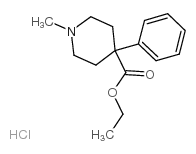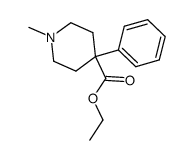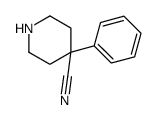50-13-5
| Name | ethyl 1-methyl-4-phenylpiperidine-4-carboxylate,hydrochloride |
|---|---|
| Synonyms |
pethidine hydrochloride
1-Methyl-4-phenyl-piperidin-4-carbonsaeure-aethylester,Hydrochlorid Dolantal Antiduol Dispadol Dolestine Meperidine Hydrochloride Algil Chlorbycyclen Centralgin meperidine HCl Dolantin 1-methyl-4-phenyl-piperidine-4-carboxylic acid ethyl ester,hydrochloride Dolargan Dolaren |
| Density | 1.0858 |
|---|---|
| Boiling Point | 282°C |
| Melting Point | 186-189° |
| Molecular Formula | C15H22ClNO2 |
| Molecular Weight | 283.79400 |
| Flash Point | 11 °C |
| Exact Mass | 283.13400 |
| PSA | 29.54000 |
| LogP | 2.95300 |
| Index of Refraction | 1.5200 |
| Storage condition | 2-8°C |
| Water Solubility | Very soluble in water, freely soluble in alcohol. |
|
Section 1. Chemical Product and Company Identification Meperidine HClCatalog Common Name/ Number(s). Trade Name CAS#50-13-5 Manufacturer
RTECSNS5950000 SPECTRUM CHEMICAL MFG. CORP. TSCATSCA 8(b) inventory: No products were found. Commercial Name(s)Not available. CI# Not available. SynonymNot available. IN CASE OF EMERGENCY Not available. Chemical Name Chemical FamilyNot available.CALL (310) 516-8000 C15H21NO2.HCl Chemical Formula SPECTRUM CHEMICAL MFG. CORP. Section 2.Composition and Information on Ingredients Exposure Limits TWA (mg/m3)STEL (mg/m3) CEIL (mg/m3) NameCAS #% by Weight 1) Meperidine HCl50-13-5100 Toxicological DataMeperidine HCl: on IngredientsORAL (LD50):Acute: 170 mg/kg [Rat]. 178 mg/kg [Mouse]. 500 mg/kg [Rabbit]. Section 3. Hazards Identification Potential Acute Health Effects Hazardous in case of eye contact (irritant), of ingestion, . Slightly hazardous in case of skin contact (irritant, permeator), of inhalation (lung irritant). Severe over-exposure can result in death. Potential Chronic HealthCARCINOGENIC EFFECTS: Not available. MUTAGENIC EFFECTS: Not available. Effects TERATOGENIC EFFECTS: Not available. DEVELOPMENTAL TOXICITY: Not available. Repeated exposure to an highly toxic material may produce general deterioration of health by an accumulation in one or many human organs. Meperidine HCl Section 4. First Aid Measures Eye ContactCheck for and remove any contact lenses. Immediately flush eyes with running water for at least 15 minutes, keeping eyelids open. Cold water may be used. Do not use an eye ointment. Seek medical attention. Skin ContactAfter contact with skin, wash immediately with plenty of water. Gently and thoroughly wash the contaminated skin with running water and non-abrasive soap. Be particularly careful to clean folds, crevices, creases and groin. Cold water may be used. Cover the irritated skin with an emollient. If irritation persists, seek medical attention. Wash contaminated clothing before reusing. Serious Skin ContactNot available. InhalationAllow the victim to rest in a well ventilated area. Seek immediate medical attention. Serious InhalationEvacuate the victim to a safe area as soon as possible. Loosen tight clothing such as a collar, tie, belt or waistband. If breathing is difficult, administer oxygen. If the victim is not breathing, perform mouth-to-mouth resuscitation. Seek medical attention. IngestionDo not induce vomiting. Examine the lips and mouth to ascertain whether the tissues are damaged, a possible indication that the toxic material was ingested; the absence of such signs, however, is not conclusive. Loosen tight clothing such as a collar, tie, belt or waistband. If the victim is not breathing, perform mouth-to-mouth resuscitation. Seek immediate medical attention. Serious Ingestion Not available. Section 5. Fire and Explosion Data Flammability of the Product May be combustible at high temperature. Auto-Ignition Temperature Not available. Flash PointsNot available. Flammable LimitsNot available. Products of CombustionThese products are carbon oxides (CO, CO2), nitrogen oxides (NO, NO2...). Fire Hazards in Presence of Not available. Various Substances Explosion Hazards in Presence Risks of explosion of the product in presence of mechanical impact: Not available. Risks of explosion of the product in presence of static discharge: Not available. of Various Substances SMALL FIRE: Use DRY chemical powder. Fire Fighting Media and InstructionsLARGE FIRE: Use water spray, fog or foam. Do not use water jet. Not available. Special Remarks on Fire Hazards Special Remarks on Explosion Not available. Hazards Section 6. Accidental Release Measures Small SpillUse appropriate tools to put the spilled solid in a convenient waste disposal container. Large SpillUse a shovel to put the material into a convenient waste disposal container. Meperidine HCl Section 7. Handling and Storage PrecautionsKeep locked up Keep away from heat. Keep away from sources of ignition. Empty containers pose a fire risk, evaporate the residue under a fume hood. Ground all equipment containing material. Do not ingest. Do not breathe dust. Avoid contact with eyes Wear suitable protective clothing In case of insufficient ventilation, wear suitable respiratory equipment If ingested, seek medical advice immediately and show the container or the label. StorageKeep container dry. Keep in a cool place. Ground all equipment containing material. Keep container tightly closed. Keep in a cool, well-ventilated place. Highly toxic or infectious materials should be stored in a separate locked safety storage cabinet or room. Section 8. Exposure Controls/Personal Protection Engineering ControlsUse process enclosures, local exhaust ventilation, or other engineering controls to keep airborne levels below recommended exposure limits. If user operations generate dust, fume or mist, use ventilation to keep exposure to airborne contaminants below the exposure limit. Personal ProtectionSplash goggles. Lab coat. Dust respirator. Be sure to use an approved/certified respirator or equivalent. Gloves. Personal Protection in Case of Splash goggles. Full suit. Dust respirator. Boots. Gloves. A self contained breathing apparatus should be used a Large Spillto avoid inhalation of the product. Suggested protective clothing might not be sufficient; consult a specialist BEFORE handling this product. Exposure LimitsNot available. Section 9. Physical and Chemical Properties Physical state and appearance Solid. (Solid powder.)OdorOdorless. TasteNot available. 283.8 g/mole Molecular Weight ColorWhite. pH (1% soln/water)Not available. Boiling PointDecomposes. Melting Point187°C (368.6°F) Critical TemperatureNot available. Specific GravityNot available. Not applicable. Vapor Pressure Vapor DensityNot available. VolatilityNot available. Odor ThresholdNot available. Water/Oil Dist. Coeff.Not available. Not available. Ionicity (in Water) Dispersion PropertiesSee solubility in water, methanol. Easily soluble in methanol. Solubility Soluble in cold water. Insoluble in diethyl ether. Meperidine HCl Section 10. Stability and Reactivity Data The product is stable. Stability Instability TemperatureNot available. Not available. Conditions of Instability Not available. Incompatibility with various substances CorrosivityNon-corrosive in presence of glass. Special Remarks onNot available. Reactivity Special Remarks onNot available. Corrosivity PolymerizationNo. Section 11. Toxicological Information Routes of EntryEye contact. Inhalation. Ingestion. Toxicity to AnimalsAcute oral toxicity (LD50): 170 mg/kg [Rat]. Chronic Effects on Humans Not available. Other Toxic Effects onHazardous in case of ingestion, . HumansSlightly hazardous in case of skin contact (irritant, permeator), of inhalation (lung irritant). Special Remarks onNot available. Toxicity to Animals Special Remarks onNot available. Chronic Effects on Humans Special Remarks on otherMay Be Habit Forming Toxic Effects on Humans Section 12. Ecological Information EcotoxicityNot available. BOD5 and CODNot available. Products of BiodegradationPossibly hazardous short term degradation products are not likely. However, long term degradation products may arise. The products of degradation are more toxic. Toxicity of the Products of Biodegradation Special Remarks on theNot available. Products of Biodegradation Meperidine HCl Section 13. Disposal Considerations Waste Disposal Section 14. Transport Information DOT ClassificationCLASS 6.1: Poisonous material. : Alkaloid Salt, Solid, n.o.s.(Meperidine Hydrochloride) : UN1544 PG: III Identification Not available. Special Provisions for Transport DOT (Pictograms) HARMFUL STOW AWAY FROM FOODSTUFFS 6 Section 15. Other Regulatory Information and Pictograms TSCA 8(b) inventory: No products were found. Federal and State Regulations California Proposition 65 Warnings Other RegulationsOSHA: Hazardous by definition of Hazard Communication Standard (29 CFR 1910.1200). WHMIS (Canada) CLASS D-1B: Material causing immediate and serious toxic effects (TOXIC). Other Classifications DSCL (EEC)R25- Toxic if swallowed. R36- Irritating to eyes. Health Hazard HMIS (U.S.A.)3 National Fire Protection 1 Flammability 1 Association (U.S.A.) Fire Hazard 3 0 Reactivity Health Reactivity 0 Specific hazard Personal Protection E WHMIS (Canada) (Pictograms) DSCL (Europe) (Pictograms) TDG (Canada) (Pictograms) 6 Meperidine HCl ADR (Europe) (Pictograms) Protective Equipment Gloves. Lab coat. Dust respirator. Be sure to use an approved/certified respirator or equivalent. Wear appropriate respirator when ventilation is inadequate. SECTION 16 - ADDITIONAL INFORMATION N/A |
CHEMICAL IDENTIFICATION
HEALTH HAZARD DATAACUTE TOXICITY DATA
MUTATION DATA
|
| Symbol |

GHS06 |
|---|---|
| Signal Word | Danger |
| Hazard Statements | H301 |
| Precautionary Statements | P301 + P310 |
| Personal Protective Equipment | Eyeshields;Faceshields;Gloves;type P2 (EN 143) respirator cartridges |
| Hazard Codes | T,F |
| Risk Phrases | 25-39/23/24/25-23/24/25-11 |
| Safety Phrases | 26-36/37/39-45-36/37-16-7 |
| RIDADR | UN 1544 |
| RTECS | NS5950000 |
| Packaging Group | III |
| Hazard Class | 6.1(b) |
|
~45% 
50-13-5 |
| Literature: AUSPEX PHARMACEUTICALS, INC. Patent: US2011/160244 A1, 2011 ; Location in patent: Page/Page column 11 ; US 20110160244 A1 |
|
~% 
50-13-5 |
| Literature: AUSPEX PHARMACEUTICALS, INC. Patent: US2011/160244 A1, 2011 ; US 20110160244 A1 |
| Precursor 2 | |
|---|---|
| DownStream 0 | |

